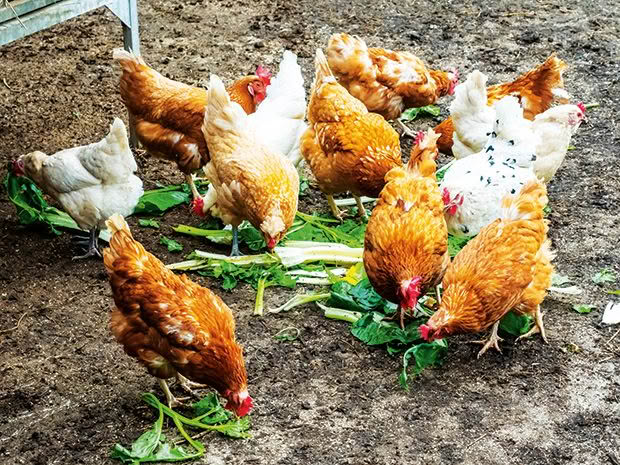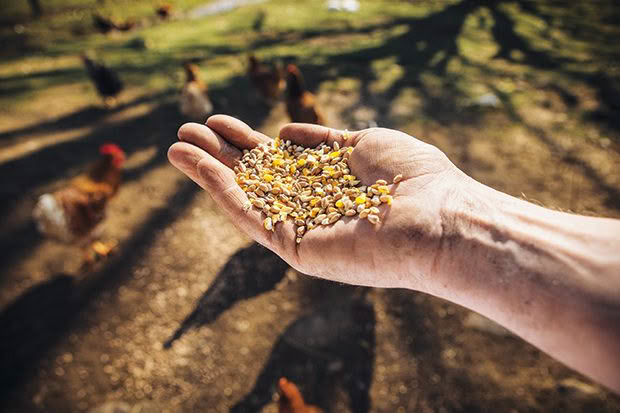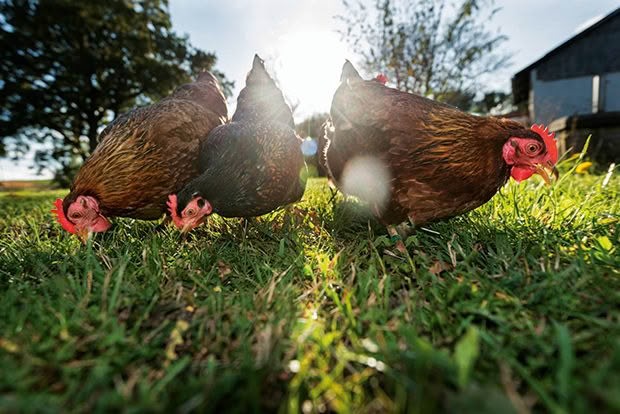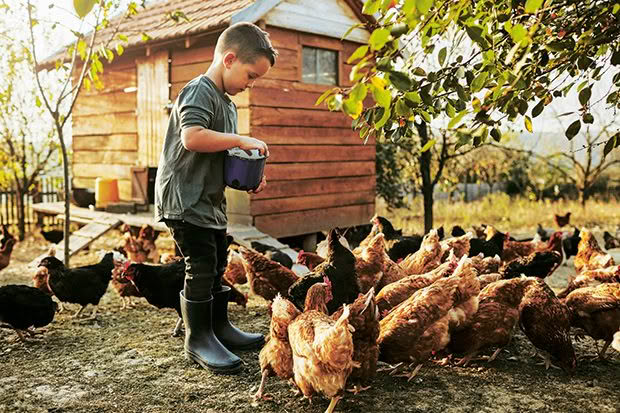When chicken feed ain’t chicken feed

With global supply chain woes now affecting feed prices, poultry owners may need to get creative to keep costs down.
Words: Andrea Graves
Whoever coined the saying “that’s chicken feed” to describe a paltry sum of money would be shocked at how costly today’s chicken-keeping has become. The phrase is an Americanism from nearly two centuries ago when a tiny bit of grain supplemented barnyard chickens’ scratching and foraging. But today, even backyard chickens are nourished mainly by purchased poultry feed from plastic bags. And because the contents of those bags come from supply lines squeezed by chaotic global events, they are becoming increasingly more expensive.
For me, this is an uncomfortable reminder that feed is a flaw in my so-called self-sufficiency. I make compost. I grow fruit and vegetables without bought-in fertiliser. I mend clothes and cook from scratch. But the naked truth is that for eggs, this chicken-keeper is as dependent on large-scale global food systems as a McDonald’s addict.
UNHEALTHY RELATIONSHIPS
One of the main ingredients in purchased chicken food is wheat, which is included as a source of carbohydrate. About a third of global wheat production came from Ukraine and Russia. At first glance, this might not seem to matter because New Zealand poultry food manufacturers buy wheat from Australia. However, countries that previously bought Ukrainian and Russian wheat have turned to Australian wheat, so the price has exploded, says Clare Burndred, CEO of Takanini Feeds. To make matters worse, she says, the international shipping system is severely disrupted, and our small group of islands at the bottom of the planet are a low priority for logistics companies.
Infrequent ship visits are affecting another major chicken feed ingredient: soymeal. The meal is what’s left after oil has been extracted from soybeans, and manufacturers include it to provide the amino acids chickens need. Most of the soymeal that goes into New Zealand poultry food comes from the US, and it, too, is likely to get costlier, says Clare. Not only is its supply hampered by shipping problems, but, like most large-scale crops, it’s grown with nitrogen-based fertiliser, which is made using increasingly pricey natural gas.
TRIMMING COSTS
The economics of the poultry and egg sectors mean it still pays to keep your own birds. That’s because although a bag of chicken feed will probably become even more expensive next year, commercial egg farmers face the same increase, some or all of which will be passed on to shoppers. You get more eggs per dollar by buying layer feed instead of store-bought free-range eggs, even when you include other costs such as pullets, straw or wood shavings.
There’s always the option of buying cheaper eggs or cheaper feed, but a race to the bottom on price has compromises, usually environmental or animal welfare-related, so I for one am not interested in it.
I buy Hy-Line pullets – which along with brown shavers are the cheapest – preferably purchased at point of lay so you’re not feeding them before they’re laying.
It also pays to consider chickens at the opposite end of life. While young birds are prolific layers after they reach puberty, their productivity drops off considerably as they age. Right now I’m afraid things aren’t looking rosy for my oldest bird, who by eating but not laying is failing to earn her keep. This weekend my neighbour plans to plant a tree, and a dead chicken is excellent fertiliser.
She’s had a great life, and I dread the act of killing, but there is no guarantee she will lay again when springtime lengthens the days. It may seem cold-hearted, but I’m a poultry keeper, and I need to keep costs down and focus my resources on the young birds who are giving us plenty of eggs.

SUPPLEMENTING
Rising prices remind us that we need to turn to our own production capacity to reduce dependence on the international food system. Feed manufacturers have moved in this direction by commissioning New Zealand grain growers to sow more wheat this year, says Clare. Although it will be grown on our shores, it will not come cheap. So unless you buy from an affordable supplier of locally-grown grain, it’s wise to look at how we can get creative with home feed to keep costs down.
There are many different alternative feed options, but we have to remember that supplementing commercial food is the same as diluting it. Layer feed is formulated by animal feed specialists with a great deal of knowledge about the nutrients needed to maximise egg production.
We should note what’s in commercial food – carbohydrates, amino acids, fat, vitamins and minerals, and calcium – and try to replicate that nutrition as much as possible. We won’t be able to completely replace commercial feed, but at least we can reduce our reliance on it. The home chicken-keeper doesn’t have the same expectations as a commercial farmer, but we do want to preserve the nutritional balance and keep our chickens and eggs healthy.
One supplement option is peas. They grow well in New Zealand and some feed manufacturers use them instead of soy. However, most use peas only as an addition to soy – not as an outright substitute. My own chickens leave dried peas in the bottom of the feeder, although they love leftover peas from dinner. Another option is New Zealand-grown meat and bone or fish meal. They are an excellent source of protein, but again, will need to be combined with other feed for a balanced diet.
For people with enough space, allowing your birds to range freely lets them do some of the work of finding extra sustenance. They’ll do this with gusto, although garden fencing will probably be required.
You’ll already be feeding your birds your food scraps, but can you cast the net wider to your neighbours’ uneaten meat, fat, peas, beans (not dry or raw) and tofu? I shudder to think of decent protein being trucked away, so even cat food rejected by fussy felines is a valuable resource. However, any deal you rustle up with your neighbours would need to stipulate keeping scraps refrigerated until you feed them out.
I grow vegetables for my birds, which is easier than it sounds if you let plants self-seed. There’s always a corner for nutritious greens at my place and perennials like silverbeet, mizuna, New Zealand spinach and comfrey will take care of themselves once established. Oats grow rampantly when sown in autumn and chickens love their sweet leaves. They also love to pick the seeds out of spent sunflower heads – try the cultivar Giant Russian.
One of the wisest moves to keep costs down is to get a decent feeder. Chickens waste food all the time, and an effective dispenser means as little as possible is going to sparrows and other pests.
I swear by my Grandpa’s Feeder, which is ten years old and still going strong.

TINY FARMS
Invertebrates are chock-full of protein and thrive on waste. This includes snails and cockroaches, which I now find to be slightly less unpleasant because of the joy they bring to my chickens. Snail hunting is the only time I’ve felt the thrill that many say they feel when hunting or fishing for larger beasts. For a more reliable source of invertebrates, consider farming worms or mealworms. In warm weather it’s worth considering maggot farms (a flash name for a dead possum covered in straw as it rots in a hanging, holey-bottomed bucket) or soldier fly farms.
Remember that for most of us, these efforts might put a dent our chickens’ feed requirements but will not replace them, or provide a complete diet. By getting creative, however, we should be able to lessen our reliance on expensive inputs and make chicken keeping more viable.
It some ways, it’s also about saving the grain for the people that need it. The United Nations secretary-general said in May that 276 million people were food insecure. The Russian invasion in Ukraine threatens to tip tens of millions more people into that state, he said. Many of these people live in countries that rely heavily on European wheat. They don’t have the luxury of feeding it to animals; it keeps their children alive.
If New Zealanders were all able to use a little less imported feed, we could, in our own little way, help relieve the pressure on these vital supply chains – and the prices might come down, too.

HOW TO MAKE A MEALWORM FARM
While mealworms are expensive to buy as a supplement feed, you can grow them at home for a fraction of the cost. The larvae of the darkling beetle, mealworms are high in protein and will reproduce in large numbers after you establish a farm.
1. Start by preparing an old plastic or glass box or tub as the farm container. This can be as small as a shoebox, but mealworms tend to thrive in a larger space around 30cm wide, 30cm deep and 60cm long. Clean and dry the container and cover with mesh. Place in a warm, dark environment – the worms do best at around 27 °C and 70% humidity.
2. Add your substrate (feed for mealworms). You can use rolled oats, wheat flour, or cornmeal. Cover the bottom to about 5cm deep.
3. Add live mealworms. You’ll need several hundred to start – these can be purchased online or at your local petstore. The mealworms should be no more the 3cm deep once in the container. Add 1 ½ cups of fresh chopped vegetables every two to three days.
4. Let them grow and reproduce. Top up the substrate whenever it drops below 5cm deep and remove any bits of mouldy food. It will take three months or so for the mealworms to complete their life cycle and produce a new generation of worms for feed. They’ll first change into pupae after four to six weeks, and then change into beetles after one to three weeks. The beetles will then reproduce, lay their eggs and die.
5. Feed the new generation of mealworms to your chickens once they are big enough.
Maintenance: Remember to discard the substrate and clean the bin after you harvest the first mealworms.
Love this story? Subscribe now!
 This article first appeared in NZ Lifestyle Block Magazine.
This article first appeared in NZ Lifestyle Block Magazine.
